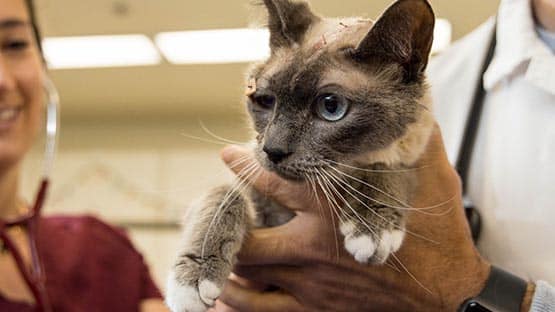
After a four-hour operation that included complex brain surgery, Jada, a 3-year-old Siamese cat, is now seeing signs of improvement at home.
Tian Xu and Jamie Liang, Jada’s owners and graduate students at Virginia Tech, noticed that their cat had balance and mobility problems and tended to lean on her right side.
They took Jada to the Veterinary Teaching Hospital on the Virginia Tech campus where she was diagnosed with a middle ear infection. She was treated with an ear cleaning and antibiotics.
However, Jada’s symptoms didn’t improve, and it became apparent that Jada was dealing with a more serious issue.
“We started with a neurologic examination and found that she had a lot of deficits that localized somewhere intracranially. Trying to decide further what was going on needed an MRI,” said neurology resident Christina Vezza.
The MRI revealed that the ear infection had spread to the cat’s brain where it had created an abscess, and surgery was required to remove the infection.
The first of two surgical teams with the Virginia-Maryland College of Veterinary Medicine removed a brain infection, swiftly followed by a second team that cleared up the ear infection.
“One of the unique aspects of this case was the location of the abscess in the cat’s brain” said Assistant Professor of Neurology Richard Shinn. “Due to the cat’s anatomy, accessing the abscess was extremely challenging. If we attempted to approach it from below, the mandible [jawbone] would obstruct our path, requiring us to open the jaw to gain access. However, in cats, most of the blood flow to the brain originates from this region. Opening the jaw would disrupt the blood flow, leading to additional complications.”
The team performed surgery with the aid of Brainsight, a navigation system that helps guide the surgery. Brainsight can be used to detect the location of an instrument, creating a visualization that appears like a real-time CT scan to guide the surgeon. There is a learning curve involved in understanding how to set it up effectively, and it requires a significant investment in resources and time.
As a result, the adoption of this system is limited, as it is not frequently used or seen in many educational and healthcare settings.
“The visualization was still quite difficult. But we were able to use this instrument to say yes, this is absolutely where the abscess is, so we could start taking it out without worrying,” said Shinn.
After nearly three hours of intense work, Jada was only halfway there.
Following the brain surgery, Justin Ganjei, adjunct assistant professor of small animal surgery, and his team performed a second surgery to clean Jada’s middle ear and remove a polyp in the nasopharynx area.
Jada still has follow-up appointments and another MRI in the future.
However, her coordination is improving, and she can jump and be more active.
“On her most recent checkup, she’s walking around much better, displaying increased coordination,” Shinn said. “Previously, she would attempt to jump but often ended up falling. However, now she’s become more coordinated.”










